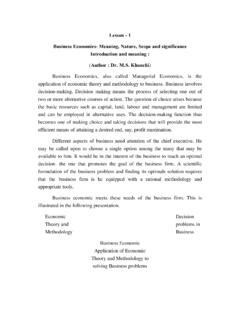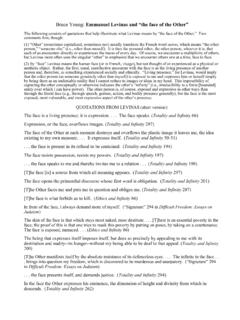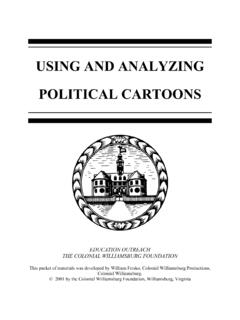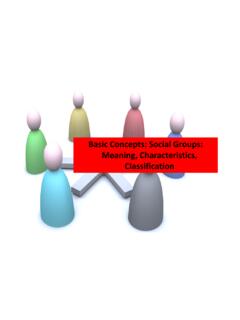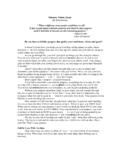Transcription of Enneagram Overview
1 This figure is not just symbolic of the Enneagram , it actually is the Enneagram . This means that the Enneagram system is not just a mental construct made-up by a person it s an independent system based on precise geometric relationships involving the circle, its nine points, and various connecting lines. So once we have a basic grasp on how the system works, we can explore it for ourselves, using its geometry as a we first look more closely, what we see is a circle with nine points placed on it so that they are equidistant (40 apart). The points (called Enneagram types or points of view) are connected by an interesting series of lines that are symmetrical vertically although not horizontally. There are many other interesting characteristics of the geometry, but the three essential features are the circle, the points, and the Enneagram is a universal system with many applications.
2 It has a number of unique features, one of which is its association with this intriguing-looking geometric figure: 1 Enneagram Overview2 The Positive EnneagramThe Circle, Points, and Lines The geometry of the Enneagram has a profound meaning . It serves as a symbolic reminder about the nature of life and life pro-cesses. The circle represents wholeness, the points represent the nine different ways in which life can manifest, and the lines, the energetic ties that connect the parts with the we just look at the inner lines themselves, we can also break them up to create two other figures: the triangle and the s also an energy flow associated with these inner lines, as shown by the arrows on these figures:&= 3 The Nine TypesAlthough the Enneagram can be used for multiple purposes, it s most often used today as a system for distinguishing nine different patterns of motivation that give rise to nine personality types.
3 Each point on the Enneagram circle represents one of the types. However, I see the nine points as representing something more basic than personality something more like innate temperament or disposition. So I prefer to think of the types as energy types, motiva-tion types, or individuality types. But for simplicity s sake, I refer to the Enneagram the same way as everybody else does: as the personality of the types can be described in many ways, depending on our purpose. However, the most basic way of describing the types is simply with a number a number associated with one of the nine points on the Enneagram circle: Referring to the nine types by number gives us an objective way to talk about each type, while at the same time allowing us to change the type label according to application.
4 Type One is always Type One, but Type One can also be called the Pioneer, Definer, Law-maker, Judge, Crusader, etc., depending on the context. We ll look at a variety of these contexts in order to see the different dimensions of the the approach of using a number as the most basic designa-tor for each type gives us an open-ended way of thinking about the Enneagram and the types. It supports a creative way of looking at our individuality: as a single essence but with an infinite number of manifestations. 2345678914 The Positive EnneagramOf course, using numbers to describe the types is not terribly in-formative, especially for newcomers. So we do use labels and descrip-tions to talk about the energy associated with the type.
5 The labels I ve chosen are designed to give a flavor of the type but without pejorative are the first of many descriptions of the types. You ll no-tice that each time I describe the type, I usually do it a little differently, from a slightly different angle. So although we have here just one label per type (to keep things simple at the start), at the end we wind up with many labels, each of which reflects a different facet of the same 2 introduces the types in more depth; subsequent chapters break down into wing types, subtypes, and points in a The Perfectercareful, conscientious, serious, single pointed, idealizing, values-oriented 2 The People Personsupportive, involved, concerned, committed, interactive, people-oriented3 The Self-testerbusy, practical, Type A, aspiring, competitive, adaptive, task-oriented4 The Deep Sea Diversensitive, aesthetic, intense, deep, creative, original, meaning -oriented5 The Puzzle-solvershy, detached, ingenious, reflective, private, innovative, knowledge-oriented 6 The Stewardcautious, ambivalent, skeptical, sensing, anxious, equivocating, safety-oriented 7 The Improvisercurious, fun-loving, restless, shifting, entrepreneurial.
6 Stimulation-oriented8 The Masterstrong, assured, masterful, grounded, frank, magnetic, power-oriented 9 The Storytellerkind, unassuming, imaginative, open, accepting, fair, nature-orientedThe Nine Types 5My Take on the TypesThere are three key assumptions I make when talking about the nine Enneagram types:type is with us for life (we never switch types)1. type is innate (with us from birth)2. type is a source of positive motivation3. The first of these assumptions that type is with us for life is based on traditional teachings on the Enneagram . The second and third are is often said to be the product of early childhood condition-ing. But it makes more sense to consider it innate. For one thing, our type never changes; if we start out as Type 3, we stay Type 3 for life .
7 For that reason alone, it would make sense to assume that type is in-nate, that it is mysteriously hard-wired into our circuitry. Otherwise, it could potentially change. But a more telling reason is that research on infant cognition and perception overwhelmingly supports the idea that individuality is present from birth. When the Enneagram teachings were first disseminated in the 1970s, this research was not yet conclusive and the influence of both The Nine Types on the Enneagram1 - Perfecter2 - People Person3 - Self-tester4 - Deep Sea DiverPuzzle-solver - 5 Steward - 6 Storyteller - 9 Master - 8 Improviser - 76 The Positive Enneagrambehaviorism (which held that infants were blank slates) and Freud-ian theory (which characterized young infants as completely self-absorbed) was still strong.
8 So that s why the Enneagram types were assumed to be the product of conditioning, which was assumed from a Freudian viewpoint to have a more or less detrimental effect on the developing infant. As a result, the personality that emerged in early childhood was almost sure to be deficient in some effort was made to subject these ideas to serious empirical scrutiny but they nevertheless became very influential. As a result, those who originally developed and taught the personality Enneagram were considerably influenced by them. Viewing personality as basi-cally the same thing as an Enneagram type, they attributed to type an essentially negative character. Type became viewed as a false self that was said to obscure our original state of essential being.
9 The nine types were said to represent nine ways that the self becomes fixated, compulsive, and everyone who learned the Enneagram received more or less the same teaching, this view of the types as distorted versions of the self became widespread. However, the basic assumptions of this view have been increasingly undercut by scientific research, especially research on genetics and infant development. This research shows that many psychological attributes that we once saw as the effects of social conditioning and maladjustment are actually innate, including the basic structures of the personality. That s why it becomes hard to avoid the conclusion that the basic structures of personality (and therefore Enneagram type) are present at birth, not acquired later on.
10 It we throw out the idea that type is a form of conditioning, we can also throw out the idea that type is inherently neurotic, disturbed, or fixated. If type exists from birth (at least in nascent form), then it cannot be defined as disturbed unless we want to make the claim that human nature is inherently unbalanced. I m not willing to make that claim, and I doubt that many other people are, assume that theory will eventually catch up with practice. Meanwhile, I am developing an approach to the Enneagram and the nine types based on a more positive assessment of human personal-ity and potential. 7 The Three Energy Centers One of the easiest ways to get acquainted with the types is by look-ing at the kind of energy associated with them.

